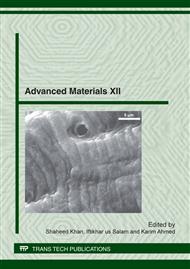[1]
Rashid MS. Relationship between steel microstructure and formability, in Formable HSLA and dual-phase steels. Davenport AT: AIME; 1977. p.1–24.
Google Scholar
[2]
Speich GR, Miller RL. Mechanical properties of ferrite–martensite steels. In: Davenport AT, editor. Structure and properties of dualphase steels. New York (NY): TMS-AIME; 1979. p.145–82.
Google Scholar
[3]
Hansen SS, Pradhan RR. Structure/property relationship and continuous yielding behavior in dual-phase steels. In: Kot RA, Bramfitt BL, editors. Proceedings fundamentals of dual-phase steels, 1981. p.113–44.
Google Scholar
[4]
Balliger NK, Gladman T. Work hardening of dual-phase steels. Met Sci 1981; 15(3): 95–108.
DOI: 10.1179/030634581790426615
Google Scholar
[5]
Ahmad E, Mazoor T, Hussain N, Qazi NK. Effect of thermomechanical processing on hardenability and tensile fracture of dual-phase steel. Mater Design 2008, 29, pp.450-457.
DOI: 10.1016/j.matdes.2006.12.022
Google Scholar
[6]
Sarwar M, Priestner R. Influence of ferrite–martensite microstructural morphology on tensile properties of dual-phase steel. J Mater Sci 1996; 31: 2091–5.
DOI: 10.1007/bf00356631
Google Scholar
[7]
Ahmad E, Mazoor T, Hussain N. Thermomechanical processing in the intercritical region and tensile properties of dual phase-steel. Mater Sci Eng A, 2009, 508, pp.259-265.
DOI: 10.1016/j.msea.2009.01.056
Google Scholar
[8]
Park KS, Park KT, Lee DL, Lee CS. Effect of heat treatment path on the cold formability of drawn dual-phase steel. Mater Sci Eng A, 2007, 449-451, pp.1135-1138.
DOI: 10.1016/j.msea.2006.02.243
Google Scholar
[9]
Sarwar M, Manzoor T, Ahmad E, Hussain N. The role of connectivity of martensite on tensile properties of a low alloy steel. Mater Design 2007, 28, p.1928-(1933).
DOI: 10.1016/j.matdes.2006.05.010
Google Scholar
[10]
Lee H. S., Hwang B, Lee S, Lee C G and Kim S J. Effect of Martensite Morphology and Tempering on Dynamic Deformation Behaviour of Dual Phase Steels. Mat. Trans. 35A 2004, pp.2371-2382.
DOI: 10.1007/s11661-006-0217-5
Google Scholar
[11]
Fang X, Fan Z, Ralph B, Evans P and Underhill R Effects of Tempering Temperature on Tensile and Hole Expansion Properties of a C-Mn Steel. J. Mater Proc. Tech., 132 (1-3), 2003, pp.215-218.
DOI: 10.1016/s0924-0136(02)00923-8
Google Scholar
[12]
Sun S, Pugh M. Properties of thermomechanically processed dual-phase steels containing fibrous martensite. Mater Sci Eng 2002; 335(1–2) p.298–308.
DOI: 10.1016/s0921-5093(01)01942-6
Google Scholar
[13]
Sarwar M, Priestner R. Hardenability of austenite in a dual-phase steel. J Mater Eng Perform 1999; 8(3) p.380–4.
DOI: 10.1361/105994999770346954
Google Scholar
[14]
Ahmad E, Priestner R. Effect of rolling in the intercritical region on the tensile properties of dual-phase steel. J Mater Eng Perform 1998; 7(6) p.772–6.
DOI: 10.1361/105994998770347341
Google Scholar
[15]
Speich GR, Demarest VA, Miller RL. Formation of austenite during intercritical annealing of dual-phase steels. Metall Trans A 1981; 12 p.1419–28.
DOI: 10.1007/bf02643686
Google Scholar
[16]
Das D and Chattopadhyay P P, Influence of martensite morphology on the work-hardening behavior of high strength ferrite-martensite dual-phase steel, J. Mater. Sci (2009), 44, pp.2957-2965.
DOI: 10.1007/s10853-009-3392-0
Google Scholar
[17]
Magee CL, Davies RG. On the volume expansion accompanying the fcc and bcc transformation in ferrous alloys. Acta Metall 1972; 20 p.1031–43.
DOI: 10.1016/0001-6160(72)90137-x
Google Scholar
[18]
Moyer JM, Ansell GS. The volume expansion accompanying the martensite transformation in iron–carbon alloys. Metall Trans A 1975; 6: p.1785–91.
DOI: 10.1007/bf02642308
Google Scholar
[19]
Gerbase J., Embury J.D., Hobbs RM. The mechanical behavior of some dual phase steels with emphasis on the initial work hardening rate. in, Structures and Properties of Dual Phase Steels, TMS-AIME, Warrendale P.A., 1979, p.118–1443.
Google Scholar
[20]
Rigsbee JM., VaderArendm PJ. Laboratory studies of microstructures and structure-property relationships in dual phase, HSLA steels, in Formable HSLA and dual-phase steels. Davenport AT: AIME; 1977, p.56–86.
Google Scholar


